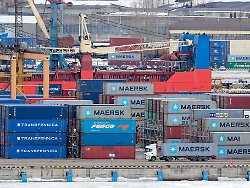steel to trade
What are the new sanctions against Russia?
3/12/2022, 5:06 p.m
An export stop for luxury goods, no more steel imports, new trade barriers: the EU and its allies have agreed on new sanctions against Russia. Many details are still unclear. The Ifo Institute nevertheless expects that these will have a negative impact on the country.
The Ifo Institute believes that the planned new Western sanctions against Russia will have further negative effects on Russia. On Friday, the EU states agreed with the USA and other allies on further punitive measures because of the Russian war of aggression against Ukraine. In addition to an EU export ban on luxury goods and an import ban on steel, this also includes new trade barriers.
Specifically, Russia is to be deprived of the so-called most-favoured-nation status in terms of trade. A statement by the G7 states talks about ongoing preparations for a statement by a broad coalition of WTO members. In fact, that comes very close to being expelled from the World Trade Organization (WTO), said the head of the Ifo Center for Foreign Trade, Lisandra Flach. According to Flach, the import duties would not rise immediately as a result. But without most-favoured-nation status, trading partners would be more flexible in raising tariffs or other trade barriers.
Under WTO agreements, countries are not normally allowed to discriminate between their trading partners. This principle is referred to as most-favoured-nation status and is the central right of WTO membership. The challenge for the global economy is how to punish a country while maintaining a rules-based trading system. Meanwhile, the planned EU export ban on luxury goods is primarily aimed at Putin’s many wealthy supporters. “Those who keep Putin’s war machine running should no longer be able to indulge in their pompous lifestyles while bombs are falling on innocent people in Ukraine,” said European Commission President Ursula von der Leyen on Friday shortly after a summit of heads of state and government EU in Versailles near Paris.
EU largest buyer region for Russian steel
The new EU sanctions package also provides for a ban on the import of “essential goods in the iron and steel sector from the Russian Federation”. This is a blow to a central sector of the Russian economic system and deprives the country of export earnings in the billions, said von der Leyen. According to the Steel Industry Association, the EU is the largest customer region for Russian steel, accounting for 30 percent of exports. Germany accounts for around two percentage points of this. Conversely, last year a fifth of all steel imports into the EU came from Russia. This corresponded to a quantity of almost 9.1 million tons. About a million tons came from Belarus. Belarus’ share of total imports into the EU was two percent.
According to the Bundesverband Deutscher Stahlhandel (BDS), annual steel consumption in the EU is around 150 million tons. In 2020, 20 percent of this came via imports into the EU. Mass-produced steels are mainly delivered to Europe from Russia, which are used in the construction industry, for example. According to the BDS, if there is an import ban on Russian steel, traders will try to procure the missing quantities elsewhere on the world market.
The world’s two largest steel producers are India and China. They could make up for a Russian default, said steel expert Jayanta Roy from the Indian rating agency ICRA. According to the Indian rating agency CRISIL, more than a third of India’s steel exports have gone to Europe. However, the BDS expressed skepticism about steel deliveries from the Far East. Freight rates have risen several times worldwide, which makes deliveries from distant regions less profitable, said BDS board member Oliver Ellermann.
